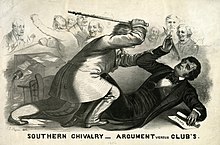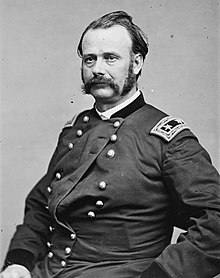Timeline of violent incidents at the United States Capitol
Abolitionist Republicans Cadwallader Washburn and John F. Potter tore a wig off the head of Democrat William Barksdale, a slave owner who later became a Confederate general.
"[18] After weeks of bitter verbal conflict on and off the floor of the House of Representatives, Lovell Rousseau of Kentucky, a Union Army General during the U.S. Civil War, beat Josiah Bushnell Grinnell of Iowa in the East Front House portico of the Capitol, hitting him repeatedly with a steel-tipped cane, while Rousseau's armed supporters stood by.
[19][20] Charles Kincaid was a journalist covering Congress who wrote stories critical of Congressman William P. Taulbee in the late 1880s, accusing him of financial corruption and having an extramarital affair.
Instead, he placed the bomb underneath a telephone switchboard in a Senate reception room, where it exploded late at night causing significant damage but no casualties.
[23] Muenter then traveled to New York City and placed a small bomb on board the SS Minnehaha, an ocean liner being used as a munitions ship.
[25] On December 13, Kemmerer went to the gallery of the House of Representatives, where Congressman Louis Thomas McFadden had introduced a resolution calling for the impeachment of President Herbert Hoover, who had been defeated in his re-election bid the previous month.
On July 12, 1947, Kaiser followed Bricker into a station of the Capitol subway system, pulled out a pistol, and fired two shots at the senator, both of which missed.
[28] On October 30, 1950, under the leadership of Pedro Albizu Campos, the pro-independence Puerto Rican Nationalist Party launched a series of armed revolts around the island that were quickly suppressed.
Two days later, two party members attempted to assassinate President Harry S. Truman at the Blair House, resulting in the deaths of a policeman and one of the attackers.
Lolita Lebrón, Rafael Cancel Miranda, Andres Figueroa Cordero, and Irvin Flores Rodríguez went to the public gallery of the House of Representatives and unfurled a Puerto Rican flag, and then began shooting at members of Congress, who were debating an immigration bill.
[31] The group issued a statement saying they had attacked "the very seat of U.S. white arrogance" to protest against the invasion of Laos that had begun on February 8, hoping to "freak out the warmongers".
Israel Rubinowits, an Israeli visiting the United States, entered the Capitol on October 18, 1983, and went to the visitor's gallery of the House of Representatives.
The device which had been concealed under his clothes consisted of two plastic bottles filled with a flammable liquid, gunpowder and improvised shrapnel, and was rigged to a detonator with copper wire.
[32][33] Rubinowits later pleaded guilty to a reduced charge of disturbing Congress and received a six-month jail sentence which was suspended when he agreed to be deported to Israel and never return to the United States.
This case was cited as an example of the discriminatory differences in the punishment of Arabs and Israelis accused of similar crimes in the U.S.[34] The May 19th Communist Organization was a women-led successor to the Weather Underground.
He believed that he had the power to prevent the United States from being destroyed by a deadly disease that he called Black Heva and by swarms of cannibals.
He believed that President Bill Clinton was a Russian clone, and that there was a time machine called the ruby satellite stored in a Senate safe that would help him in his quest.
[41] On September 11, 2001, members of the Islamic terrorist group Al Qaeda hijacked and took control of the cockpits of four airliners in the United States.
Khalid Sheikh Mohammed and Ramzi bin al-Shibh, who planned the attacks and were later arrested, have claimed that the intended target of Flight 93 was the U.S. Capitol.
The attacks were first detected at the headquarters of American Media in Boca Raton, Florida which at that time owned the National Enquirer, a supermarket tabloid.
[44] The Environmental Protection Agency spent $27 million to decontaminate Capitol facilities, and it took three months to complete the work at the Hart Senate Office Building.
He then flew toward Washington, where he crossed the Potomac River and entered the highly restricted airspace that includes the White House and the Capitol.
He flew the length of the National Mall and landed on the west lawn of the Capitol, where he was promptly arrested, and his aircraft was examined by a bomb squad.
In 2015, he had attempted to bring an illegal protest sign into the Capitol and had been arrested later that year for "shouting Bible verses from the House gallery and running from an officer.
[58] When President Donald Trump was defeated in the 2020 United States presidential election, he refused to concede his loss but said he would leave the White House.
[61] Some of the participants in the attack were members of, or had previously expressed support for, fringe views or right-wing extremist groups, including the Proud Boys, Oath Keepers, and Three Percenters.
[61] The most serious charge brought in the January 6 cases was seditious conspiracy; January 6 defendants convicted of seditious conspiracy include Oath Keepers leaders Elmer Stewart Rhodes and Kelly Meggs, and six of their followers; and Proud Boys leader Enrique Tarrio and his followers Joseph Randall Biggs, Ethan Nordean, Jeremy Bertino, and Zach Rehl.
[68][67] The morning of August 19, 2021, Floyd Ray Roseberry of Grover, North Carolina, drove a pickup truck onto the sidewalk in front of the Thomas Jefferson Building of the Library of Congress.
[71][72][73][74] In a video posted to Facebook two days before the episode, Roseberry promoted far-right conspiracy theories that Democrats would be arrested, and former President Donald Trump returned to power.
[77] Early on the morning of August 14, 2022, Richard A. York III of Ocean View, Delaware, with Pennsylvania ties, crashed his car into a security barricade near the Capitol building.
















